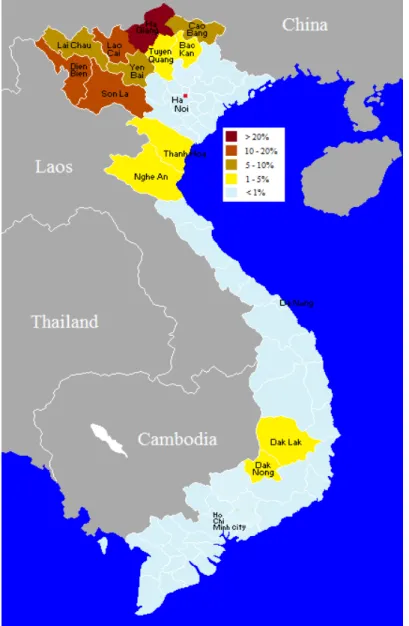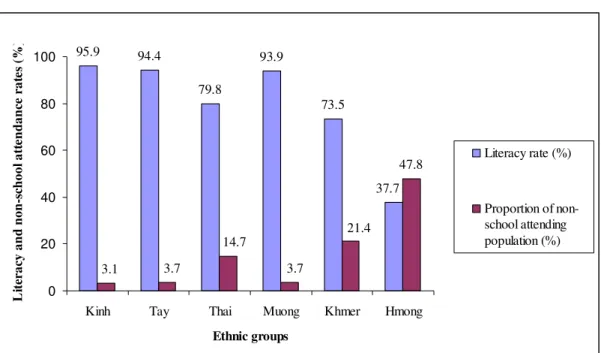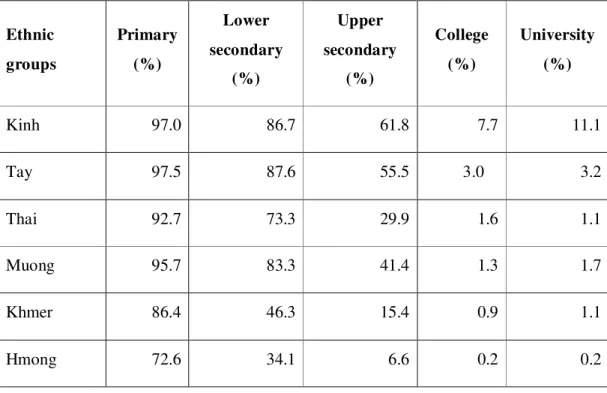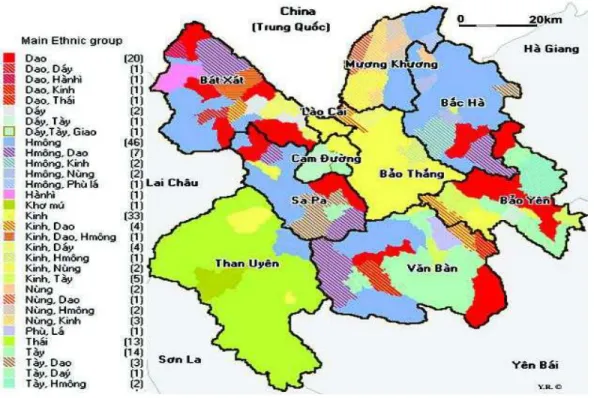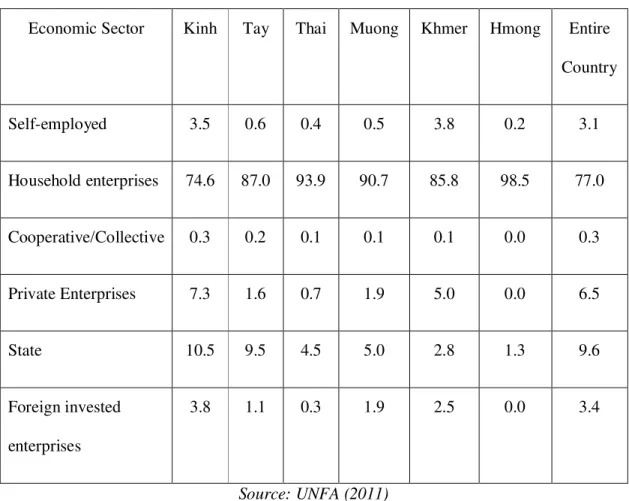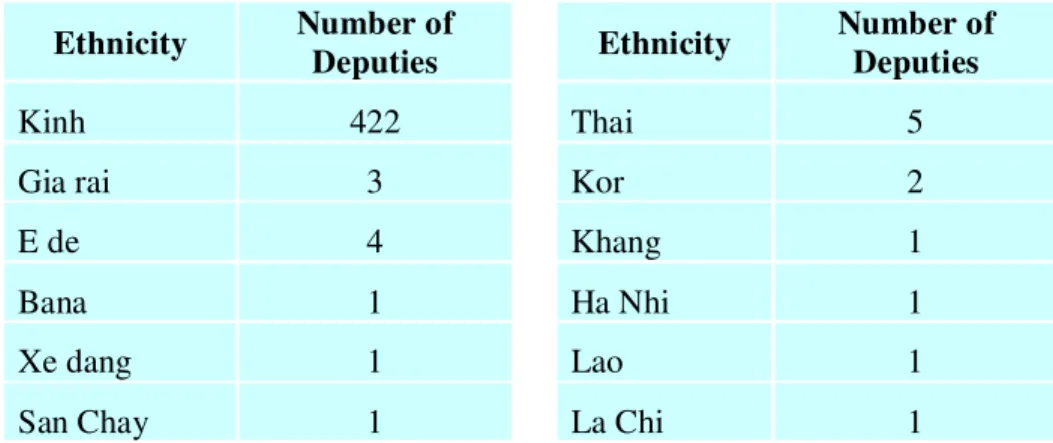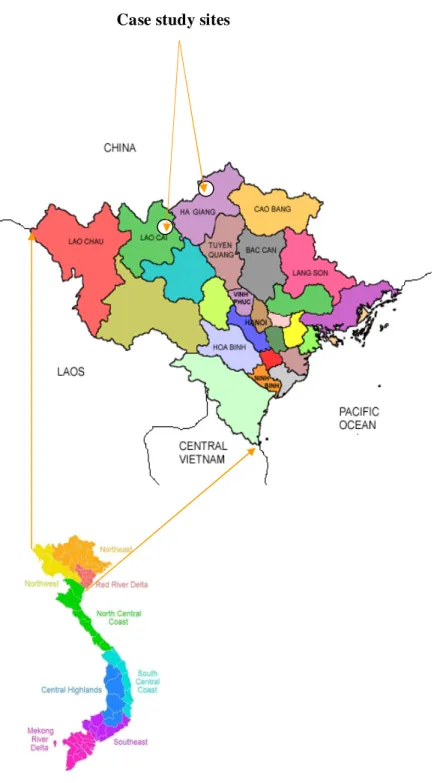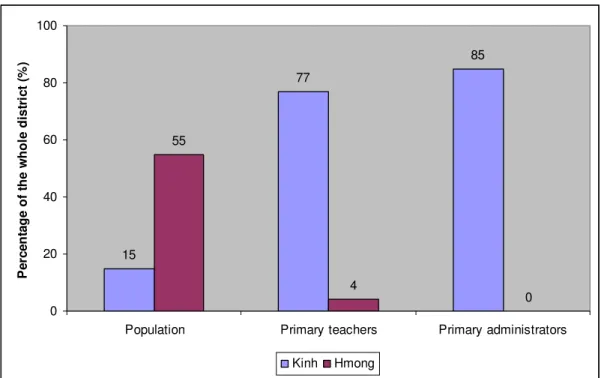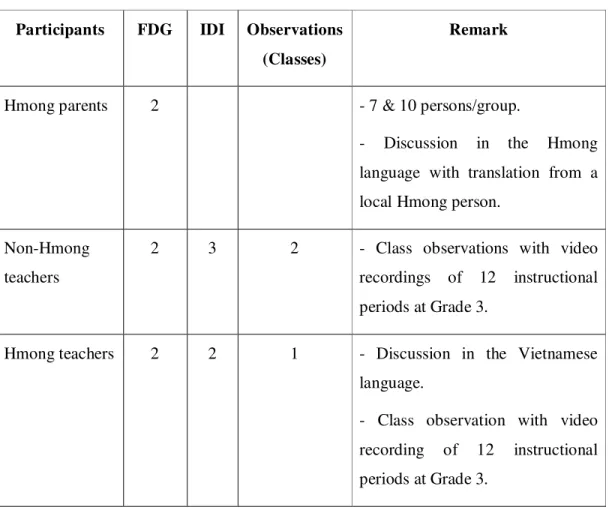1
Minority status and schooling of the Hmong in Vietnam
By
Minh Phuong Luong1; Wolfgang Nieke2
University of Rostock, Germany
Hmong Studies Journal Volume 14, 37 Pages
Abstract
This study examines the disproportionately poor academic performance of the Hmong among the minorities in Vietnam by using Ogbu’s cultural ecological theory (Ogbu, 2003). Societal and school factors have been assumed by many policy makers and scholars to affect minorities’ equally, but the paper argues that may not be the case when minority status is taken into account. “Community forces” are pointed to as the putative cause of the Hmong’s differential academic performance. “Community forces” of each ethnic group are related to their status as a minority group, which orients their interpretations and responses to schooling. In this paper, the minority status of the Hmong is explained through their group development history, settlement patterns, livelihoods and economic adaptive strategies and political participation through a review of the scholarly literature on the Hmong. Additionally, field research was conducted in Vietnam using a grounded theory approach to ethnography to understand how minority status influences community forces, and in turn, how these community forces affect the schooling of Hmong students.
Keywords: minority status, Hmong, schooling, culture, Vietnam
INTRODUCTION
The Hmong are a relatively large ethnic group with an estimated population of around 12 million throughout the world, of which the majority are living in China and the remaining residing in Laos, Thailand, Vietnam, Burma, France, the United States, Canada, Australia, French Guiana, Argentina, New Zealand, and Germany (Cha, 2010). In Vietnam, out of 54 ethnic groups, the Kinh is the largest group with almost 86% of the country’s population. Among 53 minority groups, the Hmong rank as the fifth largest group with 1.068.189 people, equivalent to 1.24% of Vietnam’s population (Census, 2009). There are more than 40 clans of Hmong who are divided into 6 groups including: Hmong Der (white Hmong), Hmong Du (black Hmong), Hmong Si (Red Hmong);
1 PhD student at the Institute of Education Science and Social Pedagogy, Faculty of Philosophy, University of Rostock, Germany
2
Hmong Dua (Green Hmong); Hmong Lenh (flowery Hmong) and Hmong Xua (Cross-bred Hmong). These groups are distinguished by differences in language, dress and custom (Institute of Anthropology, 2005). The Hmong people mainly reside in 20 provinces but the majority (over 91%) are settled in the northern mountainous regions of Vietnam including: Ha Giang (nearly 22%), Dien Bien, Son La, and Lao Cai (14-16%), Lai Chau, Yen Bai, Cao Bang (5-10%) and Bac Kan, Tuyen Quang (1-5%) where the living conditions are extremely harsh and poor. The remaining primarily live in Thanh Hoa, Nghe An provinces in the central region and Dak Lak, Dak Nong provinces in the central highlands (UNFA, 2011) (Figure 1).
Figure 1: Distribution of the Hmong people in Vietnam
3
In comparison with other minority groups in Vietnam, the Hmong have been assessed to be the most economically vulnerable with the highest poverty rate, and the lowest educational achievements. In the extremely socioeconomically impoverished communes, the Hmong have the highest proportion of family income below the new 2011 poverty line (around US$19 per person per month) (82.6%) compared to the Vietnam population (53%) and the other minority groups (below 70%) (Pham et al., 2011). Likewise, it is also recognized that the Hmong have the poorest academic performance among ethnic groups in Vietnam. Figure 2 shows a wide gap in the proportions of literacy and school attendance between the Hmong and the other ethnic groups. The level of non-school attendance among the Hmong (48%) is approximately 16 times higher than that enumerated among the Kinh (around 3%). As a consequence, data from 2009 show that the literacy rate among the Hmong is quite low (nearly 38%) while it is very high (enumerated at 94%) among larger ethnic groups such as the Kinh, Tay and Muong.
Figure 2: Literacy rate of the population aged 15 and older, and proportion of the
population aged 5 and older that has never attended school by the major ethnic
groups, 2009 95.9 94.4 79.8 93.9 73.5 47.8 37.7
3.1 3.7 3.7
14.7 21.4 0 20 40 60 80 100
Kinh Tay Thai Muong Khmer Hmong
Ethnic groups L it er a cy a n d n o n -s ch o o l a tt e n d a n ce r a te s (% )
Literacy rate (%)
Proportion of non-school attending population (%)
4
from the lowest net enrollment rates at different educational levels. Very few Hmong students in Vietnam pursue tertiary education, particularly at the college or university level (Table 1).
Table 1: Net enrolment rates at different levels of education by the major ethnic
groups, 2009
Ethnic
groups
Primary
(%)
Lower
secondary
(%)
Upper
secondary
(%)
College
(%)
University
(%)
Kinh 97.0 86.7 61.8 7.7 11.1
Tay 97.5 87.6 55.5 3.0 3.2
Thai 92.7 73.3 29.9 1.6 1.1
Muong 95.7 83.3 41.4 1.3 1.7
Khmer 86.4 46.3 15.4 0.9 1.1
Hmong 72.6 34.1 6.6 0.2 0.2
Source: General Statistics Office (Ministry of Planning and Investment, 2011) The household census in Vietnam (2009) also indicated that approximately 79% of the Hmong had not obtained an educational degree while this rate was much lower for the Kinh group, roughly 25%. Only 14.5% of the Hmong had obtained a primary educational degree, with about 5% and 2% enumerated as having completed a lower secondary and upper secondary education, accordingly (GSO, 2011).
5
biography/biology of the individual child. These factors undeniably contribute. Nonetheless, they do not persuasively explicate the disproportionately poor academic performance of some minority groups and differences among minority groups (Ogbu, 1992a&b).
The cultural ecology theory developed by Ogbu (1998, 2003) addresses two major factors, “societal and school factors” and “community forces” that significantly affect the schooling of students. “Societal and school factors” (also known as “the system”) refers to societal educational policies and practices, societal rewards for educational accomplishments or credentials, and treatment of minorities in society and in educational institutions. In response, “community forces” are the ways minorities interpret and respond to societal and school forces. They encompass cultural frames of reference (for example, comparison of themselves with the dominant society), beliefs about the instrumental value of school credentials (e.g., role of schools in life advancement); relational beliefs about or interpretations of schooling (e.g., degree of trust) and symbolic beliefs about or interpretations of identity, culture, language, ability (e.g., a threat to minority culture and language identity) (Ogbu & Simons, 1998; Ogbu, 2003).
Many policy makers and scholars have assumed that system factors affect ethnic minorities’ equality. The paper argues this may not be the case when the minority status of an ethnic group is taken into account. Minority status contributes to community forces that are associated with disproportionate and persistent problems in academic performance and literacy among the Hmong in Vietnam. The present paper addresses the minority status of the Hmong through a literature review of the existing scholarly resources about the Hmong in Vietnam. In addition, the researchers’ field study in Lao Cai and Ha Giang delineates relevant community forces through an examination of the influence of minority status on the educational experiences and perspectives of Hmong students, parents and educators.
MINORITY STATUS OF THE HMONG
6
Simons, 1998). It is also reflected in the socio-economic conditions and cultural dynamics and political participation of that group.
History of the Hmong in Vietnam
The Hmong are called Mèo in Vietnam and known as Miáo or Miáo zú in China (Culas, 2010). However, the name “Mèo” means “cat” and has been perceived as a derogatory term by the Hmong so the name “Hmong” has been officially used since 1979 (Institute of Anthropology, 2005). It has been proposed by some scholars that the Hmong group was present in China as long as five thousand years ago (Thao, 1999 & 2004; Institute of Anthropology, 2005; Cha, 2010). In around 2700 B.C., the Hmong were first present in the Yangtze region of China. At that time, the Hmong were a subgroup of a larger number of ethnic groups called by the Chinese as Miao. It has been proposed by some writers that the Hmong are descendants of the Miao King, Chi You (Thao, 1999; Institute of Anthropology, 2005; Cha, 2010). Chi You’s ruling kingdom, namely Jiuli, consisted of over 81 different clans. Huang Di, the Chinese Yellow Emperor, attacked and defeated Chi You and his people. When Chi You was killed, Huang Di became the emperor of the Jiuli tribe (Cha, 2010). Later, under the dynasty of Yao, Shun and Wu, new alliances namely, the Sanmiao, Youmiao and Miaomin were formed and developed in confrontation with the powers of the Kings. From the 16th to the 11th centuries B.C., the Sanmiao and Jingchu (or Nanman) had wealthy economies and continued their resistance against the Chinese. The Sanmiao period was a prosperous time for the ancestors of the Hmong when they settled in the northern part of the Yellow river. Then owing to the strong expansion of the Hanzu, they gradually fled to the south. After many serious defeats, the Sanmiao were finally conquered by the Chinese about 3200 years ago. Many Hmong were killed and others scattered to the rugged mountainous highlands of the southern and western regions (Institute of Anthropology, 2005; Cha, 2010).
7
the high mountains and settled in the southern highlands of China. Others crossed the borders of Guizhou, Guangxi and Yunnan provinces of China and migrated to the northern regions of Vietnam. The first major emigration of the Hmong from Guizhou (China) to Dong Van and Meo Vac districts of Ha Giang province (Vietnam) occurred more than 300 years ago (Tran, 1996; Hoang, 2002 and Institute of Anthropology, 2005). Following this, there were also several Hmong emigration movements as a result of Chinese persecution to Vietnam’s northern mountainous provinces including Lao Cai, Son La, Lai Chau and Dien Bien (Hoang, 2002; Tran, 1996).
Much of the history of the Hmong is associated with their constant struggles against the oppression of the Chinese for their ethnic independence and identity survival. The Hmong have always dreamed of an autonomous nation with their own leadership and a strong desire of freedom. This was reflected in the phenomenon of “Xưng vua” – “King self-declarations” in the Hmong regions (Tran, 1996; Hoang, 2002). However, this phenomenon was quickly confronted by the ruling regimes in Vietnam. So the history of their continuing struggles for freedom in both China and Vietnam placed the Hmong in lower power relations with both Chinese and Vietnamese rulers. In addition, being “immigrants” to Vietnam provided them a different status as well.
Settlement pattern
8
Figure 3: Ethnic diversity of Lao Cai communes, 1989 (Source: Michaud et al., 2003)
9
communication and information access have partially resulted in their poor knowledge and limited opportunities for economic development in Vietnam (World Bank, 2009).
Livelihoods and economic adaptive strategies
Some scholars have described the Hmong as being isolationist but also selectively adaptive in their livelihoods. Many Hmong in Vietnam earn their living from farming, husbandry, hunting, fishing and foraging. The principal food plants are corn and rice grown by Hmong families in the terraced fields, and even inside rocky hollows utilizing primitive farming tools. In farming work, kinship based subsistence constitutes an important feature of Hmong livelihoods. People in the same clan usually exchange help with each other (Institute of Anthropology, 2005; Hoang, 2002). The husbandry also follows the household based model in which a number of buffaloes, oxen, pigs, horses and goats, and poultry, etc. are naturally reared for the purpose of serving agricultural production and providing food. Apart from farming and husbandry, hunting and foraging from forests constitute important additional food sources. Household based handicrafts such as cloth dyeing with indigo cotton weaving, silver jewelery-making, forging and carpentry, etc. are only pursued at idle times of the agricultural cycle principally to serve daily needs and sometimes for trade (Tran, 1996, 2006).
10
Table 2: Percentage of working population by ethnic group and by economic sector,
2009
Economic Sector Kinh Tay Thai Muong Khmer Hmong Entire
Country
Self-employed 3.5 0.6 0.4 0.5 3.8 0.2 3.1
Household enterprises 74.6 87.0 93.9 90.7 85.8 98.5 77.0
Cooperative/Collective 0.3 0.2 0.1 0.1 0.1 0.0 0.3
Private Enterprises 7.3 1.6 0.7 1.9 5.0 0.0 6.5
State 10.5 9.5 4.5 5.0 2.8 1.3 9.6
Foreign invested
enterprises
3.8 1.1 0.3 1.9 2.5 0.0 3.4
Source: UNFA (2011)
11
social relations, and specific geographic variables” (Turner, 2012). Apart from economic benefits, the Hmong have decided to accept or ignore development opportunities on the basis of hoping to further the sustainability of their identity and culture (Turner and Michaud, 2008). For example, somewhat differently from the other ethnic groups, the Hmong view the market as a place for not only “commodity trading” but also “friend making” and “sentiment expressing”. Some people go to market not to trade but to meet friends and relatives or enjoy traditional food after a week of hard work (Tran, 2006; Turner and Michaud, 2008).
Despite the imperatives of the country’s renovation policies since 1986, the Hmong persist in the selective pattern in their livelihoods. They attach a strong importance to the preservation of identity and culture in their adaptive economic strategies. If an integrationist pressure is imposed on them, the Hmong tend to take a “resistant” action by leaving (Turner and Michaud, 2008).
Political participation
Although the Hmong have some representation in the political system of Vietnam, their participation actually remains very poor. At the national level, Hmong representatives account for approximately 1.4% of 500 National Assembly Deputies, compared with around 85% of the Kinh group (Table 3). At the provincial and district level, the Kinh also monopolize all the vital positions in the state apparatus despite their smaller population in some regions. For example in Lao Cai, though the minorities comprise over 64% of the population, they hold nearly 26.7% of the administrative positions at the different levels, specifically, about 20% of the management positions at the provincial level, and 26% at the district and township level (Le, 2012).
Table 3: Ethnicities represented in the 2012-2017 National Assembly
Ethnicity Number of
Deputies Ethnicity
Number of Deputies
Kinh 422 Thai 5
Gia rai 3 Kor 2
E de 4 Khang 1
Bana 1 Ha Nhi 1
Xe dang 1 Lao 1
12
Co ho 2 Hoa 2
Cham 2 Mang 1
San diu 2 Kho me 5
Tay 15 Sila 1
Mnong 1 Brau 1
S' tieng 1 Muong 7
Tho 1 Nung 3
Giay 1 Hmong 7
De Chieng 1 Dao 4
TOTALS 500
Source: National Assembly of Vietnam, http://dbqh.na.gov.vn/dantoc, accessed 2013 Although the political system secures the presence of the minority representatives in accordance with the proportion of their population, these deputies, in practice, have little voice in the system. Owing to the cultural stereotypes of the deficiencies of ethnic minority deputies (and minority populations more generally) as well as their lack of education, confidence and experience in representative functions, the ethnic minority deputies are usually viewed to be of less “capacity” and political power than Kinh deputies (Palmieri, 2010). They have very little influence on decision-making. Therefore, the presence of minorities merely formally involves them in the policy process. They cannot realize their rights to effective participation in public affairs (Verstichel, 2010).
13
negotiated, and sometimes rejected by the various actors involved” (Long, 2004). In spite of this subordination, the Hmong view themselves as “neither resisting nor submissive victims of the domination” but rather they act in their own way – the “Hmong way” (Michaud, 2011). A desire for democracy and freedom – freedom from oppression – is a central theme in the broader Hmong diaspora (Cha, 2010). A historically grounded review reveals that the Hmong do not hesitate to resist any oppressors who impose social, economic and political inequality on them as well as threatening their identity and cultural survival (Turner and Michaud, 2008; Michaud, 2011). We now turn to how the social status of the Hmong affects their schooling.
SCHOOLING OF HMONG CHILDREN
To understand the influence of Hmong minority status on the schooling of their children, a five month field study divided into two phases (3 months in 2011 and two months in 2013) was conducted in two districts, namely Bac Ha district (Lao Cai) and Quan Ba district (Ha Giang) in Vietnam’s northern mountainous region.
Overview of case study sites
14
Figure 3: Location of case study sites
(Source: http://www.mobot.org/MOBOT/research/vietnam/northern.html)
15
The Hmong constitute around 55% of Bac Ha district (Lao Cai province)’s population and 60% of Quan Ba district (Ha Giang province)’s population (BOET Bac Ha, 2013; BOET Quan Ba, 2013). The 2011 poverty rates were 49.94% and 45.9% respectively in these districts, of which more than 55% of poor households of the two districts were Hmong (MOLISA, 2012). Based on data from 2013, the Kinh population only accounted for 15% of the population in Bac Ha but approximately 77% of primary school teachers came from the Kinh group. Only 4% of enumerated teachers were Hmong. In addition, 85% of primary school administrators were Kinh while no positions were allocated for the Hmong (BOET Bac Ha, 2013). Likewise, in Quan Ba district, the Kinh made up less than 10% of the total district population but around 40% of the teaching staff were Kinh. Meanwhile, merely 4% of primary school teachers were Hmong though nearly 60% of teaching staff were of minority-origin (BOET Quan Ba, 2013).
Figure 4: Proportion of population, primary teachers and administrators among the
Kinh and Hmong group in Bac Ha district, the school-year 2012-2013
15 77 85 55 4 0 0 20 40 60 80 100
Population Primary teachers Primary administrators
P e rc e n ta g e o f th e w h o le d is tr ic t (% ) Kinh Hmong
Source: Bureau of Education and Training of Bac Ha district (2013)
16
girls, encountered more extensive and persistent problems in terms of learning the national language, communication and attendance than the other groups (UNICEF et al. 2007).
Methodology
The researchers in the present study used a grounded theory method combined with ethnography (Charmaz & Michell, 2002) and adopted qualitative tools including focused group discussions (FGD), individual in-depth interview (IDI) and participant observation in a field study within a broader framework of community based participatory and constructivist approaches (Creswell, 2009; 2012). These approaches enabled the researchers to understand the research issues from the perspective of participants for whom the meaning of their minority status was influenced by their social and historical experiences and was exposed through their interactions with others in the community or society.
Table 4: Research tools used in the field study
Participants FDG IDI Observations
(Classes)
Remark
Hmong parents 2 - 7 & 10 persons/group.
- Discussion in the Hmong language with translation from a local Hmong person.
Non-Hmong teachers
2 3 2 - Class observations with video recordings of 12 instructional periods at Grade 3.
Hmong teachers 2 2 1 - Discussion in the Vietnamese language.
17
Hmong students 2 - 10 students per group at the
lower secondary level (for age of 12-15).
- Discussion in the Vietnamese language.
Cultural expert 1 Interviewee from the Kinh ethnic
group.
* BOET: Bureau of Education and Training at district level
The grounded theory method (Charmaz, 2012) was used in collecting and analyzing the data with the support of Transana Software Version 2.5.2.
Results
The schooling of Hmong children is significantly affected by community forces that encompass four major categories including: (i) self-recognition of being more disadvantaged in both social life and schooling, (ii) loss of optimism about employment opportunities, (iii) being cautious and resistant to external forces, and (iv) strong beliefs in cultural and language heritage.
Self-recognition of being more disadvantaged in both social life and schooling
The Hmong perceive themselves as being more disadvantaged than their peers in terms of their social life and schooling. The disadvantages are manifested in their passive acceptance of learning concepts in the Vietnamese language, and a subordinated position in the dominant society that hinders Hmong students from actively participating in the classroom.
18
and 3 for the Hmong under UNICEF’s program in Lao Cai province (UNICEF, 2012). Our class observations indicated that the Hmong students would actively raise their hands when the teachers explained responses to their questions in the local language. Nonetheless, the majority of teachers did not know the local language. Hence, Hmong students encountered difficulty in understanding instruction, particularly in the early grades. Additionally, a one-size-fits-all curriculum and teaching strategy were also pointed out as great challenges confronting Hmong learning in all of the schools. Hmong students had to deal with alien concepts that they never heard of or seen before in their lives. They recognized they were more disadvantaged as poor economic conditions prevented them from having opportunities to travel out of their small isolated villages. Moreover, many of the students and their families hardly had access to information sources like television, radio and newspapers because they spent most of their time on housework and fieldwork. Meanwhile, their teachers were not properly and adequately supported in the design of relevant instructional and teaching methods and tools. Thus instruction in Vietnamese about concepts lacked the use of visual aids and did not incorporate students’ experiences. This further hindered Hmong students’ participation in the classroom. They were unable to use language to express concepts with which they had little familiarity in their daily lives, a Hmong deputy headmaster in a focused group discussion of the minority teachers in Quan Ba district stated:
…when we are in the text writing session, for example, in the exercise in... describing... a river or sea, because my mountaineer students have never seen any river or sea in their life, they do not know how to describe it... However, if you ask them to describe a spring, they can tell you how it flows on sunny or rainy days since they observe it in their actual life.
19
between what the students’ experiences were with regard to the forest and the teachers’ analysis about the causes of deforestation. This consequently made the students confused. The students’ perspective came from their daily knowledge about their living environment while that of the teachers was formed on the basis of scientific knowledge. During the instruction, the teachers simply did not recognize the role of wood in the students’ daily lives as important for their existing living conditions. In contrast, holding a stereotype about Hmong traditions, they considered wood cutting as forest destruction and mentioned the new concepts of natural disasters like flood, land erosion, etc. that the students had possibly never heard about before in their lives. As a result, by the end of the lesson, in response to the concluding question of “what are the benefits of forest plantings and protection?”, students persisted in their existing concepts (cooking, house building) and hardly remembered those introduced by their teachers (preventing land erosion and floods) though these concepts were repeated as much as seven to ten times during an instructional period (35 minutes).
The perception of being different and being in a weaker power relationship with the other ethnic groups, specifically with the Kinh and Tay groups, predominated in the Hmong community. To their view, the disadvantaged living conditions contributed to their socially marginalization from other groups. They subsequently accepted their subordinated position with resignation. A 42-year-old Hmong woman, the head of a communal women union in a focus group discussion of the Hmong parents in Quan Ba district, revealed that
…finally…finally we are the Hmong so we go, we go … go to meeting or go to workshops or anywhere else, we are surely weaker despite our literacy, despite the fact of how good our literacy is, they... they live near the cities so they are more normal people. We Hmong are living in high mountains so surely... we are weaker people.
20
…we have to herd cow and buffalo, cut grass for horses and are not allowed to play like other children. Because we are Hmong, we have to go to the mountains to do field work and follow buffaloes’ behind (all children in the focused group discussion laughed)...
The image of a “buffaloes’ behind” was spoken in a humorous but sad voice. The irony here is that buffaloes are usually under human control during field work but as he shared, Hmong children had to follow them. It shows their acceptance of a hard life with resignation. Such an image of inferiority ingrained in Hmong children likely makes them shy and cautious about forming social relationships with other ethnic groups, particularly at school.
In schools, as noted, the Hmong also possess a very poor representation in teaching positions. On average, there are fewer than five Hmong teachers out of around a total of 40 teachers in each primary school for Hmong students in Quan Ba and Bac Ha districts. Their voices or ideas are inadequately respected in schools. Hence, a sense of subordination is felt by many Hmong teachers. This gradually erodes their efforts to make their voices recognized in their institutions and reinforces their withdrawal from social interaction. A Hmong deputy-headmaster of a Quan Ba primary school shared in an in-depth interview that:
I always feel that …being Hmong…, I myself have a feeling of being marginalized in the school. I hold an inferior position in the relationship with my colleagues though I am the deputy headmaster of this school. Therefore, my… my…motivation for struggle is gradually driven back because… I am very weak and powerless in the school. I must accept my fate with resignation… I am in such position.
21
behaviors. A Hmong woman with four children of school age in a focused group discussion of the Hmong parents in Bac Ha district stated that
…We expect our children to have good marks and try their best to learn but they are dumb because at home … in Hmong homes, the worst is that we do not have desks & chairs as well as a study corner for our children. Therefore, they play outside the house after school. They have meals and they are at the school in school time. My family is very poor and we can provide them only shirts and pants for their schooling.
Further, when justifying teachers’ reprimands and even physical punishments of their children at school, the Hmong parents thought that it was their children’s language incapacity that caused teachers to get stressed as this put burdens on teachers during the teaching process. Thus they accepted the pedagogical method associated with reprimands and physical punishment though it possibly conflicted with their traditions and patterns of childrearing. A 35-year-old Hmong woman with three children of school age in Quan Ba district explained that
… Parents do not teach, parents cannot speak Vietnamese, so our children obviously cannot speak Vietnamese well. As a consequence, they do not understand what their teachers say. Therefore, if we criticize the teachers, it is not fair for them. It is just because our children do not know the language… so even though the teachers speak and speak, they still do not know and listen, hence they do not understand how to follow the teachers’ guidance. The teachers tell them to do this but they do not understand, thus they do in a different way… they wrongly do what teachers tell them. Then the teachers get angry and reprimand them. Therefore, it is not right to criticize teachers… (laughing)
22
Researcher:… You forget to do homework assigned by your teacher. What do you do when your teacher asks you?
Tau: I... do not dare to answer her. She gets angry and reprimands me.
Researcher: How do you feel when being reprimanded by the teacher in such a case?
Respondents: Sad (all students in chorus) Phuong: Cry
Mi: Self-blame
Researcher: Self-blame ↑? Why do you blame yourselves? Mai: Because I sleep in and forget to do homework.
Tau: Because we are very tired after a working day and sleep in
Cau: I feel angry with my parents because they do not provide me with adequate leaning facilities that my friends have …
Loss of optimism about employment opportunities
Hmong parents and youth were not optimistic about finding the employment opportunities that were usually seen as rewards for academic success in a society. It is often reasoned that Hmong with lower academic outcomes do not meet requirements of the labour market in Vietnam. However, the majority of the Hmong in Bac Ha and Quan Ba reflected that educational degrees would not secure their chances to earn a job. In addition to an academic degree, money and social relationships were seen as essential requirements to securing a job and the majority of Hmong families were poor and unable to obtain work through paying a fee or through social networks. This reality reinforced Hmong parents’ pessimism towards the economic prospects resulting from their children’s academic success. Consequently, the majority of Hmong parents simply expected that their children could read and write Vietnamese and acquire mathematical skills to make it possible for them to earn a living in society. In a focus group discussion of the Hmong parents in Bac Ha district, a 54-year-old Hmong man who had five children, two of whom had graduated from college but could not find a job, shared:
23
but at least they do not have to ask for help from others. When they are literate, they themselves can write a document…Because my family is very poor, we do not have money. We do not know how to earn a job in a government office. Other people are wiser so they jump in, thus our children are thrown out. In order to earn a job, we must have money but we do not. It is impossible for us.
De, a 22-year-old Hmong man had completed vocational secondary school three years earlier. He could not get a job after graduation because of a lack of ‘conditions’ that were understood as financial support and social relationships. He planned to set up a motorbike and bike repair shop but these goals still remained a plan. After failure in his job search, he returned to field work similar to his uneducated friends. He stated in the focus group discussion of the Hmong parents in Bac Ha district:
In short, when having applied for whatever job, I was told that it all depended on my conditions. Because I did not have sufficient conditions, I could not earn a job. The advancements in life associated with educational success have rarely been seen in evidence among the Hmong. To a great extent, this reality associated with the poor economic conditions further disheartened many Hmong parents from providing sufficient learning supports at home as well as Hmong students from engaging in learning at school. Hmong students often lacked learning aids such as pens, notebooks, textbooks, etc. They usually had little time at home to do their homework. The majority of Hmong children worked as additional laborers for their families after school, helping their parents with field work and housework including sibling care, water fetching, cow or buffalo herding, wood collecting, grass cutting, etc. Worse, some students were forced to skip school by their parents in order to have more time for housework and/or field work. Hmong lower secondary students participating in a group discussion in Bac Ha district stated the following:
Mai: Parents only think that we must help them to do housework after school. Tau: Parents allow us to quit school some days.
24
Phuong: Because parents did not go to school, they do not have any idea about what learning is. All they know is we must help them after school.
Being cautious and resistant to external forces
Both the Hmong and non-Hmong participants said that it was challenging to improve Hmong participation in social and school activities. The Hmong only felt free to actively participate in social activities within their own community while hesitant to engage in social communication with the other ethnic groups. Relational beliefs are considered to be key factors in enhancing social participation. These are built by removing threats to safety and setting up relationships based on trust and respect. The Hmong history of undaunted struggle shows that they are ready to resist the oppressing powers by their withdrawal when their safety and self-esteem are threatened. A massive drop-out of the Hmong students in many schools in Quan Ba district in 2011 was an example of this. In this event, students in all primary and lower secondary schools in four communes with high number of Hmong population (Can Ty, Thanh Van, Ta Van and Lung Tam) unanimously dropped out for two weeks due to issues associated with a student dental program. During the program, some children had their loose first teeth pulled out by doctors without consulting parents while Hmong traditionally let loose first teeth naturally fall out without doctor intervention. Therefore, teeth-pulling was seen as a threat to children’s safety by Hmong parents. Additionally, the Hmong often provided an oppositional response when their self-esteem was threatened. Hmong students unhesitatingly left schools when their teachers and peers made them lose face in front of others. They often dropped out after being reprimanded by their teachers or teased by their friends. A Hmong woman in a focus group discussion in Quan Ba revealed that:
“My daughter is two years older than her peers. Therefore, she feels ashamed when she is often laughed at and teased by the other students. She sometimes cries and drops out for few weeks…”
25
in the broader social context. Demographic fragmentation, particularly isolated residences caused great difficulty for the Hmong in socializing with people from the other ethnic groups. Additionally, at home and in their community, the Hmong mainly communicated with each other in their mother-tongue language. Low Vietnamese language proficiency was considered to be a sizable obstacle for the Hmong in expressing their thoughts and ideas. Consequently, it made Hmong students shy and unconfident in their classroom interactions. A grade-one Hmong male teacher with 10-years of experience teaching Hmong students in a focus group discussion involving Hmong teachers in Bac Ha district stated:
… They are shy in their communication because of their constraint of language as well. The friends from the other ethnic groups come, they possibly want to talk with them, they might know what to talk but they do not know how to correctly express it, how to explain their thought so that their friends understand what they mean …
It was also explained that the real cause behind their hesitation in active communication with the other groups in both social settings and the classroom was their fear of being laughed at and made to look ridiculous. Together with their self-recognition of being not as knowledgeable as people from the other ethnic groups, the psychology of being looked down at, being judged or ridiculed inevitably deepened the inferiority complex of Hmong students and increased their lack of confidence in communication with other ethnic groups. Such a psychological attitude was recognized and admitted to be common by the majority of Hmong participants regardless of age, gender, social status, and occupation. Therefore, the Hmong usually listened, observed and concisely responded to their partners in a passive role at first in order to determine their attitude as they looked for trustworthiness. In a focus group discussion of the Hmong teachers in Bac Ha district, a Hmong male teacher confided that:
26
In the same way, the Hmong students tended to be less active and willing to argue or contribute their ideas. They accepted their partners’ ideas without exposing any disagreement, particularly with strangers. In classrooms, students did vocally oppose their teachers’ ideas although they might find them incorrect or had different ideas. A young grade-two Hmong male teacher in Bac Ha district said:
When the students from the other ethnic groups find out a writing mistake made by their teacher on the blackboard, they will promptly respond that "Teacher, you write one word in the wrong way". They are very confident in pointing out the wrong word. In contrast, the Hmong students tend to keep silent. They do not dare to voice their ideas though they know their teacher’s mistake…
Nevertheless, the Hmong became more open and less reserved provided that trust in a relationship was recognized. A local expert on the Hmong culture in Lao Cai province stated in an in-depth interview:
…By nature, the Hmong are very active, open and friendly. They are always cautious or shy at the beginning, so you might have the feeling that they are unfriendly and frigid to you. That is just the first impression. When you gain their trust, particularly by drinking, living and eating with them, they became very open and friendly. They would open up and share all their stories. The Hmong show a very deep sentiment to you when you are considered as their close friends.
27
In a class of a Hmong teacher in Bac Ha district, it was seen that the students actively raised their hands to answer their teacher’s questions. The usual fear and shyness in communication no longer existed in this classroom where student ideas were recognized and opportunities for expression were given to them by their teacher. Some students in this classroom even corrected their teacher’s ideas when they considered them wrong. Cong, a poorly performing student in Grade 3, confidently rejected his Hmong teacher’s answer in the assignment to ‘draw generations of your family’ when she wrongly thought that his family merely had two generations.
Teacher: So you have to position yourself at a lower level. Cong should be put here, your parents are the oldest ones so you must put them on the top, here. And your younger brother is the youngest so he is drawn at the lowest level. Do you remember?
Cong: No, my parents are not the oldest but my grandparents.
Teacher: Ah, your grandparents live with your family, don’t they? So you put them on the top, then your parents.
Strong beliefs in cultural and language heritage
Being a minority with a strong sense of identity, the Hmong are very concerned about losing their own culture and language. It was explicated that each Hmong informant grew up with a strong sense of responsibility for not only their clan and family but also the preservation of their culture and language. The responsibility for culture and language preservation was reportedly formed through three different cohesive educational channels. The first was through family based teaching. Generally, Hmong men were taught their mother’s folk songs. Cultural knowledge was also instilled through teaching and advice from parents, grandparents and community elders. It is considered necessary for Hmong boys to know how to perform worship rituals, sung poetry and the Qeej instrument. For Hmong girls, it is considered very important that they are able to do housework and complex embroidery.
28
final source of culture and language transmission involved village based teaching. In a village, many interest groups including those pertaining to embroidery, hunting, cattle grazing, wood collecting, water fetching and Qeej playing were organized. In each group, knowledgeable and skillful members instructed and supported the others. A close interlink among these teaching channels strengthened the cultural knowledge and Hmong identity of youth. Strong Hmong beliefs in their own cultural heritage are further enhanced by their rather isolated pattern of settlement and selective adaptive strategies in economic development. In the view of some Bac Ha and Quan Ba educators, such strong Hmong attachments to cultural heritage obstructed the process of putting into practice the knowledge learned at school. A deputy-headmaster of a Quan Ba primary school stated:
Through their visits to students’ families, my staff realized that their students did not apply what they were taught in the school, like moral behaviors, individual hygiene, etc. into life. They persisted in their traditions and their own living style. Hence, the results we had expected were unattainable…
In contrast, the Hmong community tended to see the knowledge and skills that their children acquired from school as necessary requirements for life in a modern society. They promoted parallel systems of learning. And in their view, the learning of ethnic traditions, customs and rituals were very important. A Hmong 14-year-old male student in a focus group discussion in Bac Ha said:
…In school, the teachers teach us scientific knowledge so that we can make our living by putting it into the agricultural production. At home, our parents teach us how to behave, how to work, how to learn ethnic rituals. My parents tell me that whatever high position in the society I may hold, and wherever I live, I have to follow our traditions and customs when coming back home. Being Hmong, we must know Hmong rituals. Being Hmong, we are also responsible for preserving our culture...
29
DISCUSSION
Although minority groups account for more than 14% (Census, 2009) of Vietnam’s population, research on minority status and its impact on the education of minority children in Vietnam remains limited. Particularly, there have been few studies addressing the disproportionately poor academic performance of the Hmong in Vietnamese schools. The present study provides several initial findings on these largely unexamined issues. The World Bank (2009) highlighted substantial differences in educational performance between the majority (Kinh) and minorities and concluded that the government’s educational policies have not been able to close the gap. Furthermore, a number of previous studies on the majority-minority gap in academic achievement suggested that the poor academic performance of ethnic minority students has been attributed to a lack of parental support and familial poverty associated with language deficiency (Nguyen, 2009) as well as to the poor implementation of education policies aimed at minorities (Truong, 2011). Our results are consistent with these findings.
30
responses including: (i) the history of the Diaspora; (ii) geographical disadvantage, (iii) a lack of political and socio-economic power; (iv) and the role of a lineage and clan based culture. The psychology of being part of a Diaspora may cause the Hmong to accept their settlement in socioeconomically disadvantaged areas, and this perpetuates stereotypes about them that further exacerbate their how social status in Vietnamese society. They may respond to this unequal social treatment by separating themselves from the broader Vietnamese society and focusing their lives within their own community.
31
openly and equally interact with their peers and teachers in the classroom (UNESCO&UNICEF, 2007).
Conclusion
32
References Cited
Bureau of Education and Training of Bac Ha district (BOET Bac Ha) (2013). Annual reports on Education of Bac Ha district. Bac Ha, Vietnam: BOET.
Bureau of Education and Training of Quan Ba district (BOET Quan Ba) (2013). Annual reports on Education of Quan Ba district. Quan Ba, Vietnam: BOET.
Central Population and Housing Census Steering Committee (2010). The 2009 Viet Nam Population and Housing Census: Some Key Indicators. Available at:
http://vietnam.unfpa.org/webdav/site/vietnam/shared/Census%20publications/10_ Booklet-Some-Key-Indicators.pdf
Cha, Y.P. (2010). An Introduction to Hmong culture. Jefferson, North Carolina and London: McFarland & Company, Inc.
Charmaz, K. (2012). Constructing Grounded Theory: A practical guide through
qualitative analysis. Los Angeles, London, New Dehli, Singapore and Washington DC: SAGE.
Charmaz, K. & Mitchell, R. (2002). Grounded theory in Ethnography. In P. Atkinson, S. Delamont, A. Coffex, J. Lofland, L.H. Lofland (Eds.), Handbook of Ethnography. London, Thousand Oaks, New Dehli: SAGE.
Corlin, C. (2004). Hmong and the land question in Vietnam: National policy and local concepts of the environment. In Hmong-Miao in Asia, ed. Tapp, N.; Michaud, J.; Culas, C. and Lee, G. Y.; 295–320. Chiang Mai, Thailand: Silkworm Books.
Creswell, J.W. (2012). Educational research: Planning, conducting and evaluating quantitative and qualitative research (4th ed.) Boston: Pearson.
Creswell, J. W. (2009). Research design: Qualitative, quantitative, and mixed methods approaches (3rd ed.). Thousand Oaks, CA: Sage.
Culas, C. (2010). The ethnonyms of the Hmong in Vietnam: early history (1856-1924) and practical epistemology. In Inter-Ethnic Dynamics in Asia: Considering the Other through ethnonyms, territories and rituals, ed. Culas, C. and Robinne, F.; 13-41. Oxon and New York: Routledge.
Cummins, J. (2001). Negotiating identities: Education for empowerment in a diverse society. Los Angeles: California Association for Bilingual Education.
Gay, G. (2010). Culturally responsive teaching: Theory, research, and practice (2nd edition). New York: Teachers College Press.
General Statistics Office of Ministry of Planning and Investment (2011). Vietnam
33
General Statistics Office (GSO) (2011). Vietnam population and Housing census 2009: Education in Vietnam: an analysis of key indicators. Hanoi: MPI (Ministry of Planning and Investment).
Hoang, X. L. (2002). Cultural traits of Hmong people and solutions to preserve and enhance its values in Vietnam context. Doctoral Dissertation, Hanoi National University.
Institute of Anthropology (Vietnamese Academy of Social Sciences) (2005). The Hmong in Vietnam. Hanoi: VNA publishing house
Kosonen, K. (2004). Language in education policy and practice in Vietnam. Hanoï, Vietnam: UNICEF.
Lavoie, C. (2011). The educational realities of Hmong communities in Vietnam: the voices of teachers, Critical Inquiry in Language Studies, 8:2, 153-175.
Le, V.K. (2012). Ethnic minority staff development in Lao Cai province. Available at:
http://xaydungdang.org.vn/
Long, N. (2004). Actors, interfaces, and development intervention: Meanings, purposes and powers. In Development intervention: Actor and activity perspectives, ed. Kontinen, T., 14–36. Helsinki, Finalnd: Center for Activity Theory and Developmental Work Research and Institute for Development Studies, University of Helsinki.
Michaud, J. (2011). Hmong infrapolitics: a view from Vietnam, Ethnic and Racial Studies 2011, 1-21.
Michaud, J., Turner, S., Roche, Y. (2003). Mapping ethnic diversity in highland Northern Vietnam, GeoJournal, 57: 281-299.
Ministry of labour, invalids and social affairs (MOLISA) (2012). Decision on reviewing the surveyed results on poor households and nearly poor households 2011. Hanoi: MOLISA.
Nguyen, H.C. (2009). Local perspectives on improving the quality of primary education in poor and ethnic minority areas of Vietnam. Unpublished working paper, Young Lives and Save the Children UK.
Nieto, S. (2010). Language, culture and teaching: Critical Perspectives. New York: Routledge.
Ogbu, J.U. and Simons, H.D. (1998). Voluntary and Involuntary Minorities: A Cultural- Ecological Theory of School Performance with Some Implications for Education, Anthropology & Education Quarterly, 29(2), 155-188.
34
Ogbu, J.U. (1992b). Understanding cultural diversity and learning, Educational Researcher, 21(8), 5-14.
Ogbu, J.U. (1987). Variability in Minority School Performance: A Problem in Search of an Explanation, Anthropology & Education Quarterly, Vol. 18, No. 4, 312-334.
Ogbu, J. U. (1983). Minority Status and Schooling in Plural Societies, Comparative Education Review, 27(2) 168-190.
Palmieri, S. (2010). Representation from the top: Ethnic minorities in the National Assembly of Vietnam. Mexico: IPU and UNDP.
Pham, T. H.; Le, D.T. and Nguyen, V.C. (2011). Poverty of ethnic minorities in Vietnam: Situation and Challenges in Programme 135 Phase II Communes, 2006-07. Hanoi: Indochina Research and Consulting.
Taylor, C.; Appiah, K.A.; Habermas, J.; Rockefeller, S. C.; Walzer, M. and Wolf, S. (1994). Multiculturalism: examining the politics of recognition. Princeton, New Jersey: Princeton University Press.
Thao, P. (1999). Mong Education at the Crossroads. Lanham: University Press of America.
Thao, P. (2004). Brief history of the Hmong people. Link:
http://www.mong.ws/history.htm
The Socialist Republic of Vietnam (1992). 1992 Constitution of the Socialist Republic of Vietnam.
Tran, H.S. (1996). Hmong Culture. Hanoi: Ethnic Culture Publishing House.
Tran, H.S (2006). The factors influence the socio-economic development of Hmong community and the sustainable development solutions. Lao Cai: Department of Information and Culture.
Truong, H.C. (2011). Eliminating Inter-ethnic Inequalities? Assessing Impacts of Education Policies on Ethnic Minority Children in Vietnam, Working Paper 69, Oxford: Young Lives.
Turner, S. (2012). Making a Living the Hmong Way: An Actor-Oriented Livelihoods Approach to Everyday Politics and Resistance in Upland Vietnam, Annals of the Association of American Geographers, 102(2), 403-422.
35
UNESCO&UNICEF (2007). A human rights-based approach to Education for All: A framework for the realization of children’s right to education and rights within education. Paris and New York: UNESCO, UNICEF.
UNFPA (2011). Ethnic groups in Vietnam: an Analysis of key indicators from the 2009 Vietnam Population and Housing Census. Hanoi: United Nations Population Fund (UNFPA).
UNICEF Vietnam, UNESCO Vietnam, and MOET of Vietnam (2007). The Transition of Ethnic Minority Girls in Vietnam from Primary to Secondary Education. Draft. Hanoi: UNICEF & UNESCO, Vietnam.
UNICEF (2012). Action research on Mother Tongue – based bilingual education:
Improving the equity and quality of education for ethnic minority children in Vietnam. Hanoi: UNICEF Vietnam.
UNICEF, MOET, and SILI (2012). Lao Cai Primary Classroom Language Mapping project. Available at:
http://www.unicef.org/vietnam/Lao_Cai_mapping_profile_set.pdf
Verstichel, A. (2010). Understanding minority participation and representation and the issue of citizenship. In Political participation of minorities”, ed. Weller, M. and Nobbs, K.; 72-94. New York: Oxford University Press.
World Bank (2012). Well Begun, Not Yet Done: Vietnam’s Remarkable Progress on Poverty Reduction and the Emerging Challenges. Hanoi: World Bank Vietnam. World Bank (2009). Country Social Analysis: Ethnicity and Development in Vietnam.
World Bank, Washington, DC.
Corresponding author contact information:
Minh Phuong Luong
Institut für Allgemeine Pädagogik und Sozialpädagogik Department für Bildungswissenschaft
Universität Rostock August-Bebel-Str.28 18055 Rostock
Email: lminhphuong@gmail.com
36
Acknowledgements
The authors would like to extend special thanks to Professor Joan DeJaeghere at the University of Minnesota, who reviewed the manuscript and gave the valuable comments for the paper. We would also like to thank Dr. Mark Pfeifer, the editor of Hmong Studies Journal, who gave us his editorial support and prompt feedback within a tight deadline that helped us to strengthen it. We wish to acknowledge James Conroy for his assistance in the language editing of the first-hand manuscript. We are deeply indebted to all the local officers, educational administrators, teachers, Hmong students and their parents and community in Lao Cai and Ha Giang provinces for their strong supports and participation in the study during our field trips.
About the Authors:
37
Prof. Dr. Wolfgang Nieke is the Director of the Institute of Education Science and Social Pedagogy at the University of Rostock, Germany. He achieved his PhD degree in 1976, habilitation in 1991 at the University of Essen. He was the Director of the Institutes of Migration Research, Pedagogy for Foreigners, and Second Language Instruction at the Universities of Münster, Bielefeld, and Essen. He has been the founding professor of education science in the Faculty of Philosophy at the University of Rostock since 1993. His research interests focus on development of intercultural competence in education, education science, and multicultural citizenship.
